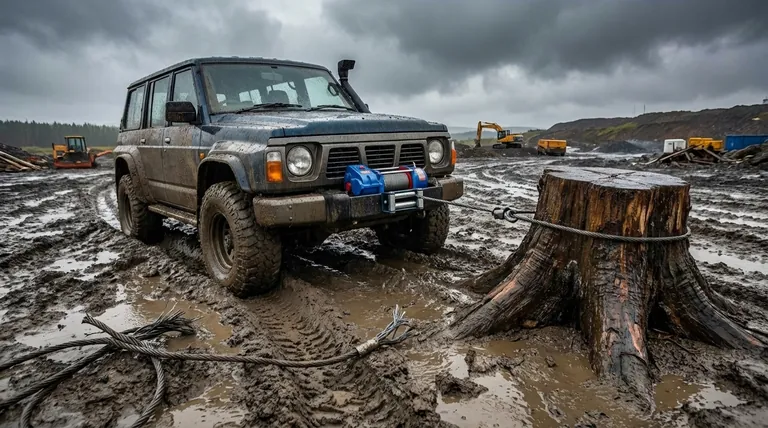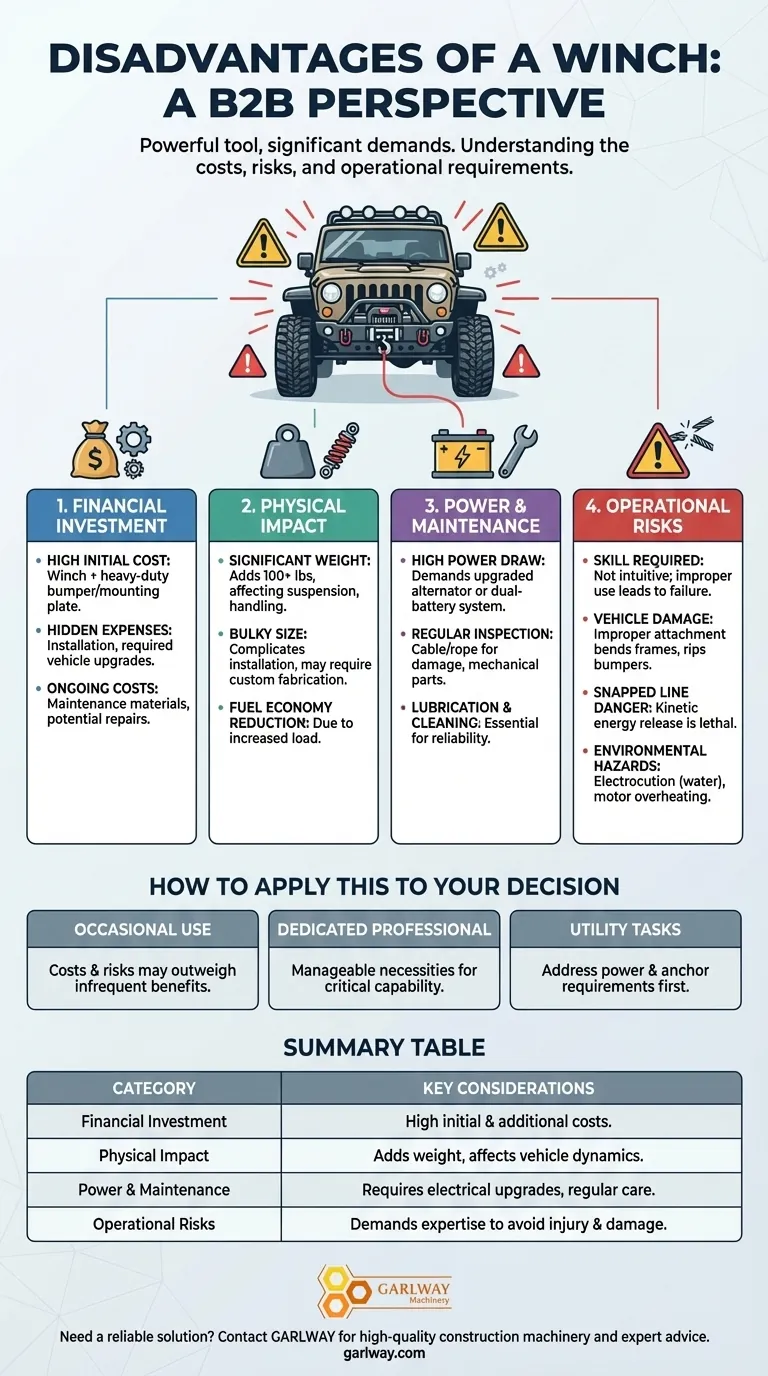While incredibly powerful, a winch is not a simple accessory. Its primary disadvantages are its significant cost, the substantial weight and bulk it adds to a vehicle, its demand for regular maintenance, and the considerable operational risks that require skill and training to mitigate safely.
A winch is a specialized, high-consequence tool. Its true disadvantages lie not just in the initial purchase price or weight, but in the ongoing commitment it demands in terms of vehicle modification, power system upgrades, and, most importantly, user knowledge to operate it without causing damage or injury.

The Practical Costs of Ownership
Before you even use a winch, you must account for its impact on your vehicle and budget. These are the logistical hurdles that come with ownership.
Initial Financial Investment
The sticker price of the winch itself is only the beginning. You often need a compatible heavy-duty bumper or mounting plate, which can be a significant additional expense.
Physical Weight and Bulk
Winches are heavy, with some models easily exceeding 100 pounds. This added weight affects your vehicle's suspension, handling, and fuel economy. Their bulky size can also complicate installation, sometimes requiring custom fabrication.
Demands on Your Power System
An electric winch places a massive load on your vehicle's electrical system. This high power draw often necessitates upgrading to a more powerful alternator, installing a dual-battery setup, or both, to avoid draining your primary battery during use.
Ongoing Maintenance Requirements
A winch is not a "set it and forget it" tool. The cable or synthetic rope must be regularly inspected for frays and damage. The mechanical components require cleaning and lubrication to ensure the winch is ready and reliable when you critically need it.
Understanding the Operational Risks
The most significant disadvantages of a winch emerge during its operation. The immense forces involved can create dangerous situations if not managed with expertise.
The Requirement for Skill
A winch is not intuitive. Safe operation requires a clear understanding of rigging principles, load capacities, and recovery techniques. Misuse doesn't just mean the winch won't work; it can lead to catastrophic failure.
Risk of Vehicle and Equipment Damage
Improperly attaching a winch can cause severe damage to both vehicles involved. The forces generated can easily bend frames or rip off bumpers if not connected to a rated structural recovery point. Overloading the winch can also lead to motor burnout or gearbox failure.
The Danger of a Snapped Line
The most cited danger is a cable or rope snapping under load. A steel cable stores a tremendous amount of kinetic energy, and if it breaks, it can whip through the air with lethal force. This is why you must never stand between the winch and its anchor point.
Environmental Hazards
Electric winches introduce specific risks. Using one in or near water can create a serious electrocution hazard. Furthermore, the motor can overheat during prolonged, heavy pulls, requiring you to monitor its temperature to prevent permanent damage.
How to Apply This to Your Decision
Understanding these drawbacks is key to making an informed choice. It's about aligning the tool's demands with your actual needs.
- If your primary focus is occasional peace of mind: The significant cost, added weight, and required training for safe use may outweigh the benefits for very infrequent recovery situations.
- If you are a dedicated off-roader or remote professional: These disadvantages are manageable necessities that you must plan for to gain the critical self-recovery capability a winch provides.
- If you need a winch for utility or workshop tasks: The power source requirements and the need for a secure, permanent anchor point are the most critical disadvantages to address before installation.
Ultimately, acknowledging the downsides of a winch is the first step toward using it as the powerful and effective asset it is designed to be.
Summary Table:
| Disadvantage Category | Key Considerations |
|---|---|
| Financial Investment | High initial cost for winch and heavy-duty mounting equipment. |
| Physical Impact | Adds significant weight, affecting suspension and fuel economy. |
| Power & Maintenance | Requires electrical system upgrades and regular inspection. |
| Operational Risks | Demands skill to avoid vehicle damage, snapped lines, and injury. |
Need a reliable winch solution without the common drawbacks?
At GARLWAY, we specialize in high-quality construction machinery, including robust and durable winches designed for demanding applications. Our experts can help you select the right equipment for your construction company or contracting business, ensuring you get the performance you need while mitigating risks.
Contact GARLWAY today to discuss your specific requirements and discover how our winches, concrete mixers, and batching plants can enhance your operational efficiency and safety globally.
Visual Guide

Related Products
- Electric and Hydraulic Winch for Heavy Duty Applications
- Warn Winch Windlass Boat Trailer Winch
- Electric 120V Boat Winch by Badlands
- Best 18000 Pound Drum Anchor Trailer Winch
- 12000 lb Heavy Duty Electric Boat Winch
People Also Ask
- How does the electric winch work? Unlock the Power of Force Multiplication
- How to power an electric winch on a trailer? Choose the Best Method for Your Setup
- How to maintain an electric winch? Ensure Peak Performance & Reliability for Your Projects
- Do electric winches have brakes? Essential Safety for Your Heavy-Duty Pulling
- How long can you run an electric winch? Master Safe, Efficient Vehicle Recovery



















